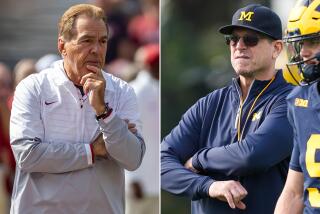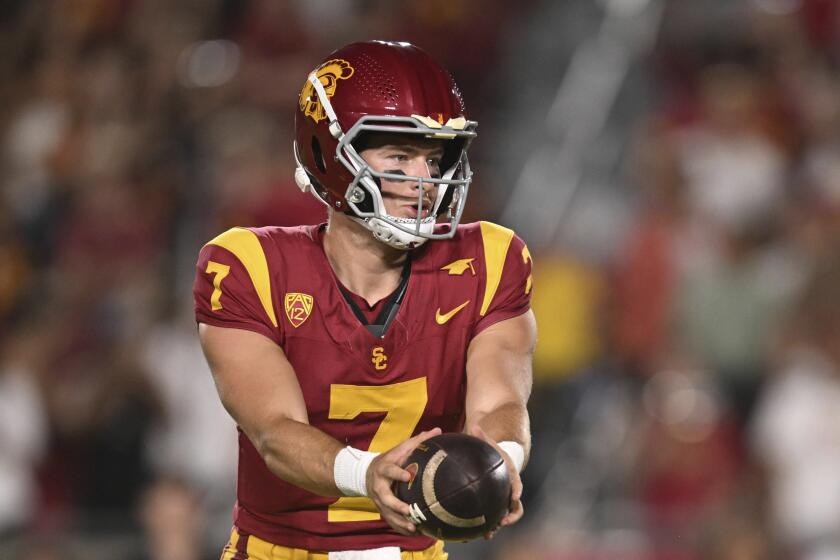East is West and up is down in college conference realignments
Tired of tracking the conference whereabouts of your favorite school?
Well, take a number and get in realignment line.
Even the people paid to cover the sport have trouble keeping up.
INTERACTIVE: Conference Realignment chart
The turning point for “yours discombobulated truly” was the announcement that Temple would be joining San Diego State in the West Division of the Big East.
Temple is in Philadelphia.
“OK, Mr. BCS bus driver, this is where I get off.”
Take last Saturday … please.
On the day Utah State won the Famous Idaho Potato Bowl as part of the Western Athletic Conference, staging its last season after being plundered out of the football business, Big East basketball filed divorce papers against Big East football.
Basketball will probably keep “Big East” as part of the settlement as the cobbled-together football wing tries to go it alone.
The 13-school football configuration sounds more like a road trip on Food Network’s “Diners, Drive-Ins and Dives.”
—Memphis (barbecue)
—Cincinnati (chili spaghetti)
—Tulane (jambalaya)
—San Diego State (fish tacos)
—Temple (cheese steak).
It’s hard to imagine why the seven Catholic basketball schools would not want to partner up for some of these Lewis and Clark excursions.
Big East Commissioner Mike Aresco, in a statement, insisted the football schools are “working together to forge a future.”
It could be a long, cold winter in Valley Forge.
We’ve even provided a color-coded map to keep up with all these conference swaps.
For example, Georgia State is now in the Sun Belt, moving up from the FCS.
The prominent schools receive more ESPN crawl space. Maryland (ACC) and Rutgers (Big East) are moving to the 14-team Big Ten. Pittsburgh and Syracuse are leaving the Big East for the ACC. Louisville is leaving the Big East for the ACC.
The Mountain West is picking up Utah State and San Jose State from the soon-to-be-defunct WAC.
But did you know Louisiana Tech is moving from the WAC to Conference USA?
The question of why all of this has happened was most honestly answered by college football TV consultant Kevin O’Malley.
“Greed was involved,” he said. “Panic was involved.”
And then his kicker: “None of this had to happen.”
College football’s history is a Gordian Knot of bowl ties and conflicting interests.
The short story is the Supreme Court, in 1984, ruled the NCAA was a monopoly by rigidly controlling college football’s television rights.
Justice Byron White, in the dissenting opinion, presciently foresaw what would happen if an “every school for itself” approach were allowed for contract bargaining.
They didn’t call him “Whizzer” for nothing.
The Supreme Court ruling turned every league into an independent contractor and the money immediately flooded to its most popular brands.
Notre Dame got its own network deal without once being asked what its record was going to be.
College football became the polar opposite of the NFL, which uses a form of revenue-sharing to keep its weakest teams strong.
College’s game turned into Gordon Gekko’s “Wall Street,” a combination of Darwinism and cannibalism.
“Conferences became sporting properties, not governing bodies,” said Karl Benson, who left the sinking WAC last year to become commissioner of the Sun Belt. “The economics changed.”
The almighty, capitalist, football-crazed SEC opened a shiny green revenue stream in 1992 by splitting into divisions and staging a title game.
Leagues began negotiating money deals at the time college football’s popularity (and ratings) started to soar.
There was no central command to monitor activities — no SEC to regulate the SEC.
Competitiveness among conference leaders started to mirror on-field rivalries like the “Iron Bowl.”
The Atlantic Coast Conference, in 2003, took a carnivorous bite when it raided the Big East of Miami, Virginia Tech and, later, Boston College.
The ACC action, a move to shore up its football frailties, started a chain reaction.
Michael Tranghese, then the Big East commissioner, maintained the move was pernicious and unnecessary — wasn’t there enough TV money for everybody?
“I don’t know where the danger is coming from,” he said of the ACC’s preemptive strike.
The move forced the Big East to raid Conference USA,and that led to a domino toppling that led to the extinction of WAC football.
The other big pivot came in 2009 when the Pac-10 replaced retiring commissioner Tom Hansen with Larry Scott, a Harvard-educated former tennis pro whose primary charge was to monetize an undervalued league.
Positioning it for the next broadcast deal, Scott made an audacious play to become the Pac-16 by adding six Big 12 schools, including Texas and Oklahoma.
When the plan collapsed, Scott added Colorado and Utah.
Scott then set the industry standard by making a 12-year, $3-billion deal with ESPN and Fox.
Some still question what added value Colorado and Utah brought to the conference.
“It’s different for each conference,” Scott said.
Scott said he needed to split into divisions and host a title game to keep his league in the national narrative.
“Big events matter,” he said.
He also maintained that expanding into other states was important in the formation of the Pac-12 Networks.
Scott considered another play for Texas last year, but his presidents made it clear they were quite fat, and happy, at 12.
Interestingly, the man who predicted the 16-team “super conferences” concept now sits geographically isolated from further expansion unless Texas comes back into play.
Boise State and San Diego State are not, at this time, serious Pac-12 considerations.
“I think we’re incredibly well-positioned,” Scott said. “We don’t see anything on the horizon we feel would put pressure on us, or provide substantial benefit, to going any bigger. Things could change. …You never say never.”
Scott does not think expansion is over.
The irony is the ACC, which started this convulsion, may be the power conference most vulnerable to attack if the Big 12, which has only 10 teams, feels the need to expand.
“Somebody else is going to get hit now,” Tranghese, who retired from the Big East in 2009, told USA Today.
ACC members Florida State and Clemson have been mentioned as possible future members.
“I couldn’t feel any better about the future of this league,” ACC Commissioner John Swofford said after adding Louisville.
The Big Ten, after adding Penn State in 1993, stood numerically challenged at 11 schools for almost 20 years before Commissioner Jim Delany recruited Nebraska two years ago.
Delany said the paradigm had shifted. “We were maybe slow to take it up.”
But did his league really need Maryland and Rutgers?
“The Big Ten is really where Rutgers belongs,” said Delany, a New Jersey native.
It has been speculated that taking Maryland was payback for Notre Dame spurning the Big Ten for a special football alliance with the ACC.
Delany acknowledged it isn’t easy making moves that might jeopardize the livelihoods of colleagues.
“It’s not the nicest side of what we’re dealing with,” Delany said.
Commissioners sometimes behave as if inspired by Sun Tzu’s “The Art of War.”
This free-for-all free market has created, in essence, two divisions of major-college football. In 2014, when the four-team playoff begins, the sport will be left with five major conferences: Pac-12, SEC, ACC, Big Ten and Big 12.
Five “other” leagues — Big East, Sun Belt, Mid-American, Conference USA, Mountain West — will fight for the table scraps.
The Big East, if it survives, needs another name. How about the Sun Rise/Sun Set League?
College football is experiencing the inevitable, if unintended, consequences of the Supreme Court’s ruling.
The lesser leagues, as they become monetarily weakened, eventually will be less able to compete on the field.
“The economic gap has become astronomical,” Benson, the Sun Belt’s commissioner, said of the divide.
Some might suggest the weeding-out process is what the free-market power commissioners wanted all along.
“I don’t know if it was intended,” Benson said. “But it certainly has occurred.”
More to Read
Get our high school sports newsletter
Prep Rally is devoted to the SoCal high school sports experience, bringing you scores, stories and a behind-the-scenes look at what makes prep sports so popular.
You may occasionally receive promotional content from the Los Angeles Times.







